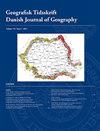了解新冠肺炎疫情对印度兰契市城市热环境的影响
IF 1.1
4区 社会学
Q4 ENVIRONMENTAL STUDIES
Geografisk Tidsskrift-Danish Journal of Geography
Pub Date : 2022-01-02
DOI:10.1080/00167223.2022.2053999
引用次数: 3
摘要
摘要:本研究旨在了解兰契市在2019冠状病毒病疫情封锁期间(2020年)地表温度(LST)和归一化植被指数(NDVI)的变化规律,并与往年进行比较。该研究结合了美国地质调查局(United States Geological Survey)的Landsat 8 (Operational land成像仪)数据,以及power.larc.nasa.gov网站2017年、2019年和2020年的气温和相对湿度数据。结果表明,城市的LST和NDVI格局发生了剧烈变化。该市4月平均地表温度从2017年的39.80℃下降到2020年的32.38℃。同样,5月平均地表温度也从2017年的38.41°C下降到2020年的34.84°C。相反,2017年4月和5月的NDVI分别为0.24 ~ 0.26,到2020年分别为0.349和0.37,呈上升趋势。此外,这座城市的空气温度下降,相对湿度增加。基于城市热场方差指数,兰契市在2020年生态优类面积相对最大,生态劣类面积相对减少。因此,降低温度,增加湿度和NDVI,形成健康的城市环境。本文章由计算机程序翻译,如有差异,请以英文原文为准。
Understanding the influence of COVID-19 induced lockdown on urban thermal environment of Ranchi city, India
ABSTRACT The objective of the study is to understand the pattern of land surface temperature (LST) and normalized difference vegetation index (NDVI) developed in Ranchi city during Covid-19-induced lockdown (2020) and its comparison with previous years. The study incorporated Landsat 8 (Operational land imager) data from United States Geological Survey and air temperature and relative humidity data from power.larc.nasa.gov for the years 2017, 2019 and 2020. The results exposed a drastic change in the LST and NDVI pattern of the city. The mean LST of the city during April has declined from 39.80°C in 2017 to 32.38°C in 2020. Similarly, the mean LST of May also declined from 38.41°C in 2017 to 34.84°C in 2020. On the contrary, the city experienced an ascending growth of NDVI from 0.24 to 0.26 in April and May 2017 to 0.349 and 0.37 in 2020, respectively. Additionally, the city portrays declining air temperature with enhanced relative humidity. Ranchi city also exhibited relatively maximum area under ecologically excellent category in the year 2020 and reduced area under ecologically the worst category based on urban thermal field variance index. Thus, reduced temperature with augmented humidity and NDVI developed a healthy urban environment.
求助全文
通过发布文献求助,成功后即可免费获取论文全文。
去求助
来源期刊
CiteScore
5.20
自引率
0.00%
发文量
5
期刊介绍:
DJG is an interdisciplinary, international journal that publishes peer reviewed research articles on all aspects of geography. Coverage includes such topics as human geography, physical geography, human-environment interactions, Earth Observation, and Geographical Information Science. DJG also welcomes articles which address geographical perspectives of e.g. environmental studies, development studies, planning, landscape ecology and sustainability science. In addition to full-length papers, DJG publishes research notes. The journal has two annual issues. Authors from all parts of the world working within geography or related fields are invited to publish their research in the journal.

 求助内容:
求助内容: 应助结果提醒方式:
应助结果提醒方式:


